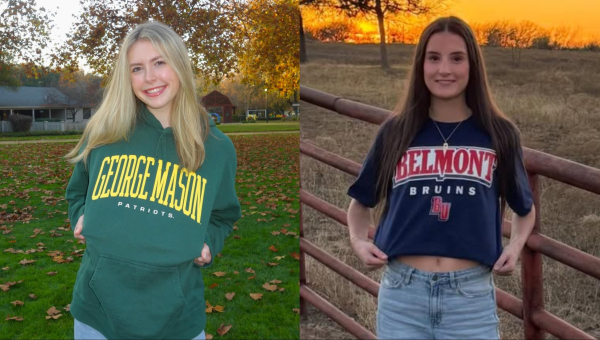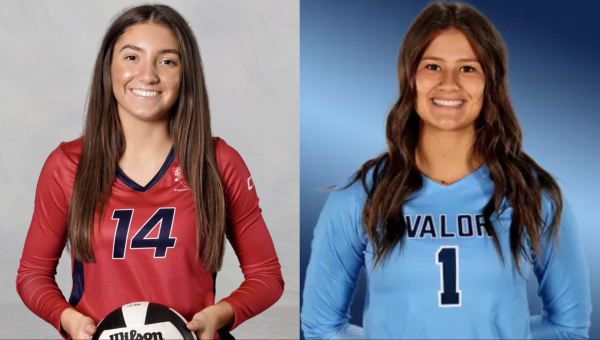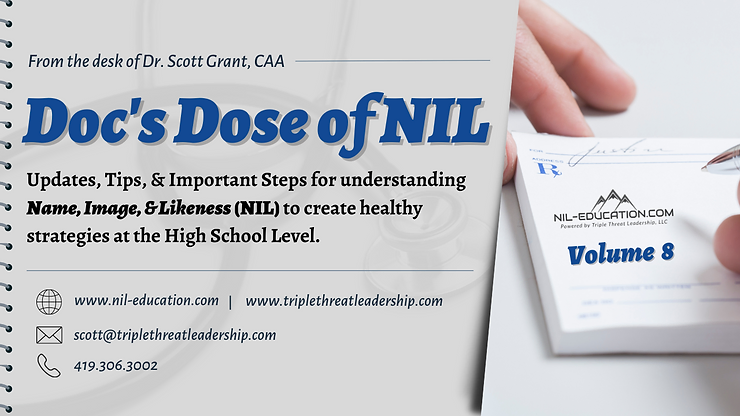
This content is provided FREE through our partnership with Dr. Scott Grant and Triple Threat Leadership/NIL Education to bring your family resources to learn the ins and outs about NIL, including the rules (each state is different), tactics, pitfalls, and marketplaces to take advantage of exciting opportunities available to student athletes.
March get’s pretty hectic here on the NIL Education front…. Some school presentations, a keynote at the New Jersey and Pennsylvania AD conferences, and then some presentations and workshops at the Iowa AD Conference.
I also had the opportunity to sit down with the leadership team at the NFHS (National Federation of High School State Associations) at their Indianapolis headquarters a few days ago.
It was an absolute blessing and honor to spend time with them discussing NIL and some of my perspectives, considerations, and key things as I work to keep the focus on how we help schools & administrators leading this new normal.
As I continue to reflect on some of the key elements that continue to pop up in my conversations with Athletic Directors / School Administrators / Educational Leaders all over, the “whether or not a student-athlete should have to disclose an NIL deal to their school” often seems to be of some concern.
Now as I dig into this a little bit, I believe there are some arguments for and against both sides, and also a way that most state associations should lean, but as always, that’s my opinion.
I’d love for lawyers, as well as school administrators, to weigh in and provide their insight.
And as always - I’m a firm believer that each school has to figure out how ALL (NIL) of this works for their respective communities.
While sometimes the issue of disclosure gets debated at the collegiate level, there hasn’t been a ton of discussion on whether this practice should be part of the High School environment / policies, and where those requirements should come from or what they should look like.
As I continue to routinely analyze the policy changes from the State Athletic Associations that now allow Name, Image, and Likeness, not all of them outline a disclosure requirement.
They set forth guidelines and regulations, but many don’t specifically require student-athletes engaging in, or preparing to engage in NIL deals to disclose those to their high school administrators.
But some do.
The answer to this discussion is not a simple one. (I don’t believe).
On the one hand, high school student-athletes are minors and often aren’t equipped with the knowledge and understanding of the legal and financial implications of entering into NIL agreements, and may not have a support structure at home to help them critically analyze what they’re potentially signing.
They may also be more susceptible to the influence of adults or other outside forces, which many would say that a disclosure requirement could help protect from potential exploitation / bad decision making.
But then that shifts the burden of the disclosure and what is actually “being done” when applying that disclosure to the school administrators.
Meaning, if the disclosure is intended to help ensure that the student-athlete is not making a bad decision, or provide an understanding of the concerns a specific potential NIL deal may provide, then that is putting a lot of pressure on the School Administrator to understand what they are reading, be willing / able to provide feedback to the student-athlete (which I wouldn’t advise), and have the time to document everything to ensure somehow a negative outcome does not fall back on them.
Contracts can get messy, and a trained professional's eye needs to look at them in order to answer many of the questions student-athletes and their families will (should) have.
I’m not a believer that adding the label of “NIL contract disclosure coordinator” is something good to be added to the already full plates of Athletic Directors.
If high schools had a designated, stand alone compliance department, sure, that makes sense.
But I honestly have never come across a high school with that structure in place to a level that wasn’t just another name for their athletic director(s).
The other interesting piece is that disclosure language isn’t consistent and when you apply it to the actions of the school administrators, it shifts the responsibility and necessary procedural methods.
For example, in the case of Pennsylvania, the disclosure comes after the student-athlete has already signed the NIL agreement. Same for Connecticut, which expands that to copies of any endorsement, employment, and representation agreements.
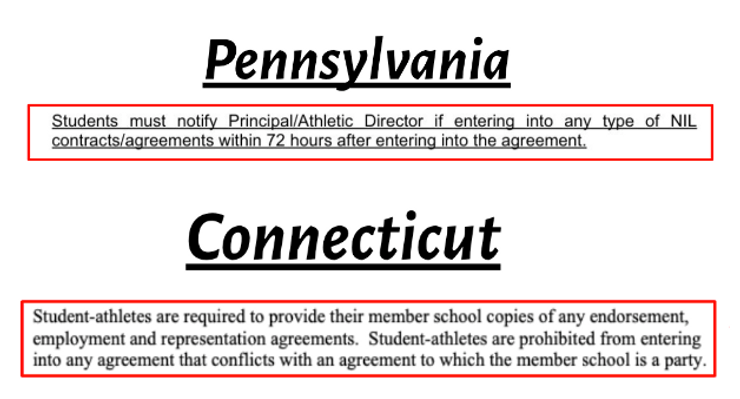
While this doesn’t seem like anything that would really impact the school administration, a few things concern me here.
#1: If the student-athlete has already signed these items, then it seems like AD’s are now being asked to go through and ensure the regulations / requirements are being met, and they aren’t violating the state athletic associations policies. Maybe not, but, if they aren’t, who is? And if not, and a rule is violated and it comes back in question after the fact, will that fall on the AD / School admin?
#2: If there is a requirement of the student-athlete to do this, then there now has to be a procedural piece that the school puts into place to ensure it happens, otherwise, it won’t happen. Let’s face it, many colleges have provided statistics that range all over the place in regards to how many student-athletes are actually disclosing their deals to them.
#3: And lastly, this disclosure element would make me nervous in regards to privacy policies, and ensuring appropriate procedural pieces are in place. Maybe I’m wrong, but I’m not sure that employment agreements of students (& even student-athletes) with places where they work are required to be turned in, so is this necessary?
Sometimes I even wonder if a high school student-athlete would have to fill out a work permit to move forward with the engagement of an NIL activity?
When I heard an Athletic Association tell a group of AD’s who asked how any of these regulations were going to be enforced and they responded with,“Well, that would be self-reporting from you all as AD’s,”
I heard an AD say, “Yeah right, that means I’m just going to tell a kid that walks into my office with an NIL deal to get out. I’m not getting entangled into that mess.”
Right. Wrong. Not my call.
But I completely understand and acknowledge that concern!
Now - on the other side of the spectrum are the people and consultants who are pushing that all state associations must include a disclosure regulation within their state policies.
Makes sense when you consider that someone has to ensure they’re not violating the rules.
It’s not about whether the contract is good or bad, or fairly written, but rather, whether the student-athlete is in violation of the state association bylaws / regulations, and what the punishment for that violation is.
Here’s where I get concerned and have questions on this side of the coin.
I believe most of the disclosure elements are being pushed onto the schools because the State Athletic Associations compliance offices are already slammed.
Maybe it’s clear from the communication that state athletic associations are continuously having with the AD’s in their states that the process for disclosures goes like this:
- Student-athlete submits the document to the school.
- School submits it to the State Athletic Association Compliance Department.
- State Athletic Association Compliance Department checks it over, and lets the AD / School know if there are any issues.
Process completed until an issue arrises.
But from the conversations I’ve had with AD’s in the states where these disclosures are required, they don’t know what they’re supposed to do with them.
Or in the case of Ohio’s potential regulations which were voted down the Spring of 2022, the AD was going to be required to understand this (and do a lot of things):
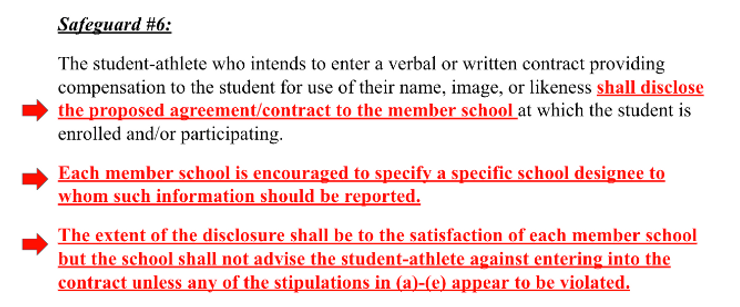
So AD’s would have been required to look at it, ensure the stipulations of the NIL / Amateurism regulations (a)-(e) weren’t violated, and then….?
They weren’t allowed to advise whether this was a terrible deal.
They just had to ensure it didn’t violate the stipulations set forth by the new NIL bylaw / regulation.
Again, even with my background in policy and love of figuring these things out, I’m not sure I would ever feel comfortable trying to decipher from legalese whether some of these things are actually being violated.
And I could be wrong, but I’m doubtful that a school superintendent and treasurer are going to allow an AD to utilize their external school attorney to do it, because those billable hours are not something the athletic department can stomach.
It’s not an easy decision, that’s for sure.
And no matter how you cut and slice it, there will always be questions in regards to the APPLICATION of the regulations, whether that includes having a disclosure or not.
But ultimately, the concern goes back to the first thing I always tell AD’s to ask of their State Athletic Associations which is:
What do these regulation changes REQUIRE me to do on a daily basis, and how does that impact the procedures, policies, and support needed on the grassroots level at my school.
That’s the support State Athletic Associations have to be focused on as they push forward these policies.
They’re leading the AD’s.
And they need their clarity and support now more than ever.


